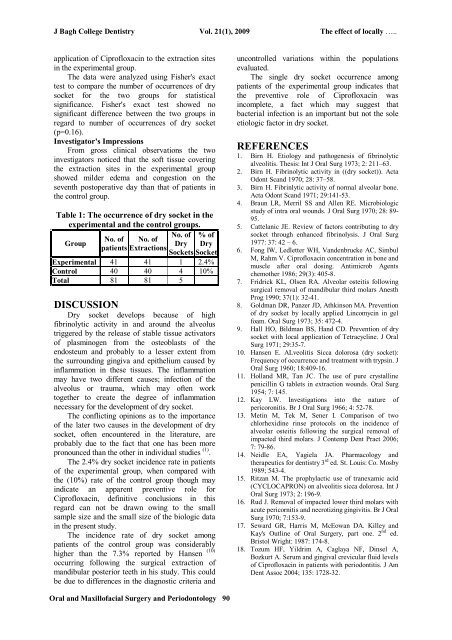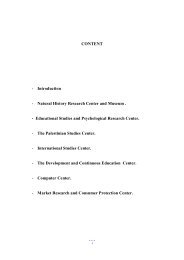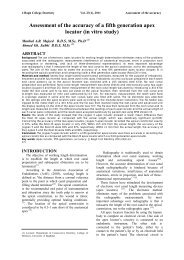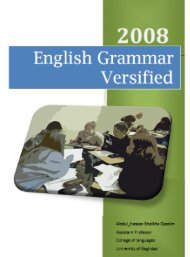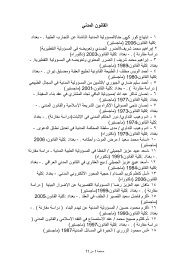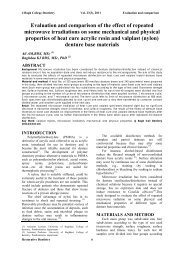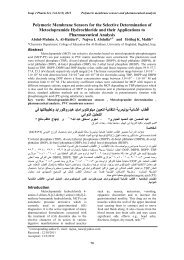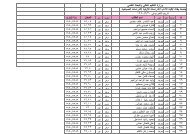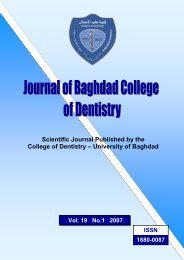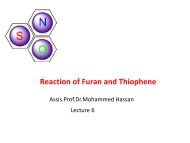Vol 21 No. 1
Vol 21 No. 1
Vol 21 No. 1
Create successful ePaper yourself
Turn your PDF publications into a flip-book with our unique Google optimized e-Paper software.
J Bagh College Dentistry <strong>Vol</strong>. <strong>21</strong>(1), 2009 The effect of locally …..<br />
application of Ciprofloxacin to the extraction sites<br />
in the experimental group.<br />
The data were analyzed using Fisher's exact<br />
test to compare the number of occurrences of dry<br />
socket for the two groups for statistical<br />
significance. Fisher's exact test showed no<br />
significant difference between the two groups in<br />
regard to number of occurrences of dry socket<br />
(p=0.16).<br />
Investigator's Impressions<br />
From gross clinical observations the two<br />
investigators noticed that the soft tissue covering<br />
the extraction sites in the experimental group<br />
showed milder edema and congestion on the<br />
seventh postoperative day than that of patients in<br />
the control group.<br />
Table 1: The occurrence of dry socket in the<br />
experimental and the control groups.<br />
Group<br />
<strong>No</strong>. of % of<br />
<strong>No</strong>. of <strong>No</strong>. of<br />
Dry Dry<br />
patients Extractions<br />
Sockets Socket<br />
Experimental 41 41 1 2.4%<br />
Control 40 40 4 10%<br />
Total 81 81 5<br />
DISCUSSION<br />
Dry socket develops because of high<br />
fibrinolytic activity in and around the alveolus<br />
triggered by the release of stable tissue activators<br />
of plasminogen from the osteoblasts of the<br />
endosteum and probably to a lesser extent from<br />
the surrounding gingiva and epithelium caused by<br />
inflammation in these tissues. The inflammation<br />
may have two different causes; infection of the<br />
alveolus or trauma, which may often work<br />
together to create the degree of inflammation<br />
necessary for the development of dry socket.<br />
The conflicting opinions as to the importance<br />
of the later two causes in the development of dry<br />
socket, often encountered in the literature, are<br />
probably due to the fact that one has been more<br />
pronounced than the other in individual studies (1) .<br />
The 2.4% dry socket incidence rate in patients<br />
of the experimental group, when compared with<br />
the (10%) rate of the control group though may<br />
indicate an apparent preventive role for<br />
Ciprofloxacin, definitive conclusions in this<br />
regard can not be drawn owing to the small<br />
sample size and the small size of the biologic data<br />
in the present study.<br />
The incidence rate of dry socket among<br />
patients of the control group was considerably<br />
higher than the 7.3% reported by Hansen (10)<br />
occurring following the surgical extraction of<br />
mandibular posterior teeth in his study. This could<br />
be due to differences in the diagnostic criteria and<br />
uncontrolled variations within the populations<br />
evaluated.<br />
The single dry socket occurrence among<br />
patients of the experimental group indicates that<br />
the preventive role of Ciprofloxacin was<br />
incomplete, a fact which may suggest that<br />
bacterial infection is an important but not the sole<br />
etiologic factor in dry socket.<br />
REFERENCES<br />
1. Birn H. Etiology and pathogenesis of fibrinolytic<br />
alveolitis. Thesis: Int J Oral Surg 1973; 2: <strong>21</strong>1–63.<br />
2. Birn H. Fibrinolytic activity in ((dry socket)). Acta<br />
Odont Scand 1970; 28: 37–58.<br />
3. Birn H. Fibrinlytic activity of normal alveolar bone.<br />
Acta Odont Scand 1971; 29:141-53.<br />
4. Braun LR, Merril SS and Allen RE. Microbiologic<br />
study of intra oral wounds. J Oral Surg 1970; 28: 89-<br />
95.<br />
5. Cattelanic JE. Review of factors contributing to dry<br />
socket through enhanced fibrinolysis. J Oral Surg<br />
1977: 37: 42 – 6.<br />
6. Fong IW, Ledletter WH, Vandenbrucke AC, Simbul<br />
M, Rahm V. Ciprofloxacin concentration in bone and<br />
muscle after oral dosing. Antimicrob Agents<br />
chemother 1986; 29(3): 405-8.<br />
7. Fridrick KL, Olsen RA. Alveolar osteitis following<br />
surgical removal of mandibular third molars Anesth<br />
Prog 1990; 37(1): 32-41.<br />
8. Goldman DR, Panzer JD, Athkinson MA. Prevention<br />
of dry socket by locally applied Lincomycin in gel<br />
foam. Oral Surg 1973; 35: 472-4.<br />
9. Hall HO, Bildman BS, Hand CD. Prevention of dry<br />
socket with local application of Tetracycline. J Oral<br />
Surg 1971; 29:35-7.<br />
10. Hansen E. ALveolitis Sicca dolorosa (dry socket):<br />
Frequency of occurrence and treatment with trypsin. J<br />
Oral Surg 1960; 18:409-16.<br />
11. Holland MR, Tan JC. The use of pure crystalline<br />
penicillin G tablets in extraction wounds. Oral Surg<br />
1954; 7: 145.<br />
12. Kay LW. Investigations into the nature of<br />
pericoronitis. Br J Oral Surg 1966; 4: 52-78.<br />
13. Metin M, Tek M, Sener I. Comparison of two<br />
chlorhexidine rinse protocols on the incidence of<br />
alveolar osteitis following the surgical removal of<br />
impacted third molars. J Contemp Dent Pract 2006;<br />
7: 79-86.<br />
14. Neidle EA, Yagiela JA. Pharmacology and<br />
therapeutics for dentistry 3 rd ed. St. Louis: Co. Mosby<br />
1989; 543-4.<br />
15. Ritzan M. The prophylactic use of tranexamic acid<br />
(CYCLOCAPRON) on alveolitis sicca dolorosa. Int J<br />
Oral Surg 1973; 2: 196-9.<br />
16. Rud J. Removal of impacted lower third molars with<br />
acute pericornitis and necrotizing gingivitis. Br J Oral<br />
Surg 1970; 7:153-9.<br />
17. Seward GR, Harris M, McEowan DA. Killey and<br />
Kay's Outline of Oral Surgery, part one. 2 nd ed.<br />
Bristol Wright: 1987: 174-8.<br />
18. Tozum HF, Yildrim A, Caglaya NF, Dinsel A,<br />
Bozkurt A. Serum and gingival crevicular fluid levels<br />
of Ciprofloxacin in patients with periodontitis. J Am<br />
Dent Assoc 2004; 135: 1728-32.<br />
Oral and Maxillofacial Surgery and Periodontology 90


